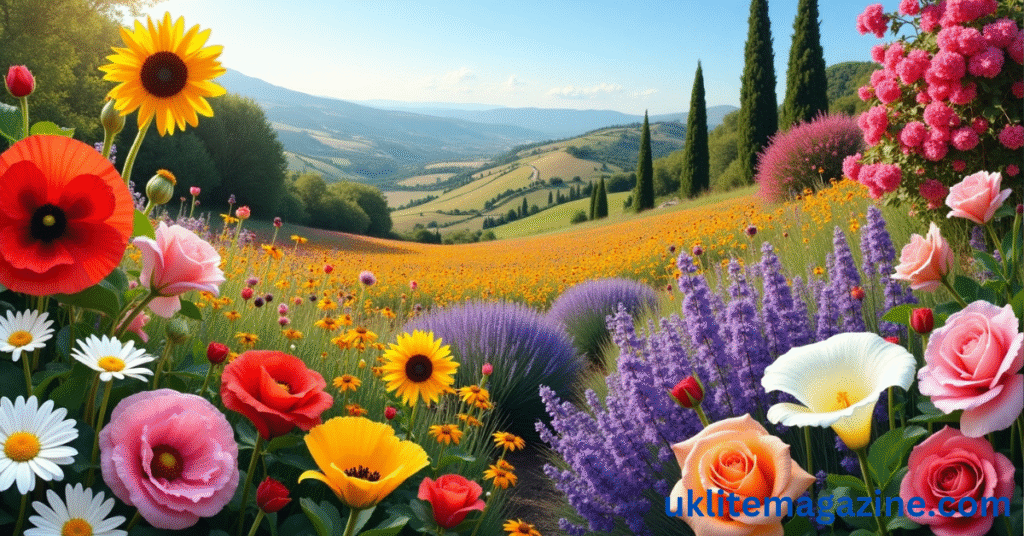Italy is not only known for its art, cuisine, and architecture but also for its stunning natural beauty. Among the many elements that add charm to the Italian landscape, flowers hold a special place. From the rolling hills of Tuscany to the cliffside gardens of the Amalfi Coast, Italian flowers reflect the country’s deep cultural roots, love for nature, and seasonal rhythms. In this guide, we’ll explore the most beautiful Italian flowers, their meanings, seasonal blooms, and where you can find them.
The Role of Flowers in Italian Culture
Flowers have been a part of Italian life and culture for centuries. In ancient Roman times, they were used in religious rituals and celebrations. During the Renaissance, flowers were common subjects in paintings and sculptures, symbolizing love, purity, and life. Even today, flowers are integral to Italian weddings, festivals, and daily expressions of affection.
One of the most colorful traditions is the Infiorata — a flower festival held in several towns where locals create stunning flower carpets on the streets using petals arranged in intricate patterns. Flowers are also used in religious processions, adding both color and meaning to spiritual events.
Most Popular Italian Flowers and Their Meanings
Lily (Lilium)
Lilies are strongly associated with purity and devotion. They are commonly found in religious artwork and church decorations, especially in Tuscany. The white lily is also linked to the Virgin Mary in Catholic symbolism.
Rose (Rosa)
Roses symbolize love and passion and are widely cultivated across Italy. From romantic bouquets to garden hedges, roses appear in many shades and are especially popular during weddings and Valentine’s Day.
Sunflower (Girasole)
The sunflower is a cheerful symbol of happiness, energy, and warmth. Fields of sunflowers bloom across central Italy, particularly in Tuscany, turning the landscape into a sea of gold during the summer.
Daisy (Margherita)
Daisies represent innocence and simplicity. They grow abundantly in Italian meadows and gardens and are a favorite among wildflowers. Interestingly, Margherita is also a common Italian female name.
Iris (Iris Fiorentina)
The iris is the official flower of Florence and represents wisdom, power, and royalty. The Iris Garden in Florence is a must-visit during its blooming season in May, offering a breathtaking display of colors.
Flowering Seasons in Italy
Italy’s mild climate makes it an ideal place for flowers to bloom throughout the year, although spring and summer offer the most variety.
-
Spring (March to May): A burst of tulips, wildflowers, irises, and poppies fill fields and gardens. This is the best time for floral sightseeing.
-
Summer (June to August): Sunflowers dominate the rural landscapes, especially in Tuscany and Umbria.
-
Autumn (September to November): Fewer flowers bloom, but you can still see late roses and vibrant chrysanthemums.
-
Winter (December to February): Flowers are limited, though evergreen plants and festive arrangements decorate homes and churches during the holidays.
Regional Highlights: Where to See Italian Flowers
Italy offers numerous destinations where flowers are a part of the natural scenery and cultural identity.
-
Tuscany: Known for endless sunflower fields and vibrant poppy meadows in spring and early summer.
-
Amalfi Coast: Streets and homes are draped with cascading bougainvillea and other colorful flowers.
-
Umbria and Lazio: These regions bloom with wildflowers in spring and host local flower festivals.
-
Florence: Visit the Iris Garden or Boboli Gardens for curated displays of Italy’s most iconic flowers.
Italian Flowers in Art and Architecture
Flowers have long been celebrated in Italian art. Renaissance painters like Botticelli often used floral motifs to represent themes of rebirth, femininity, and nature. In architecture, floral carvings and decorations adorn churches, fountains, and villas, adding elegance and meaning to these structures. Even today, flower designs influence Italian fashion, textiles, and home decor.
Conclusion
Italian flowers are more than just beautiful plants — they are living symbols of the country’s rich culture, history, and love for nature. Whether you’re strolling through sunflower fields in Tuscany, admiring iris gardens in Florence, or witnessing a vibrant flower festival in a small village, these blooms tell a story that goes beyond petals and colors. Exploring Italian flowers is a journey through Italy’s soul, one blossom at a time.
Frequently Asked Questions
Q1. What is the most famous flower in Italy?
The lily and rose are two of the most iconic and culturally significant flowers in Italy.
Q2. When is the best time to see flowers blooming in Italy?
Spring (March to May) is ideal, offering the widest range of vibrant blooms across the country.
Q3. Are there flower festivals in Italy?
Yes, including the Infiorata, where towns create stunning street art using flower petals.
Q4. What flower represents Florence?
The iris, especially the Iris Fiorentina, is the symbol of Florence and blooms in May.
Q5. Can I see sunflower fields in Italy?
Absolutely. Tuscany is famous for its golden sunflower fields in July and August.

